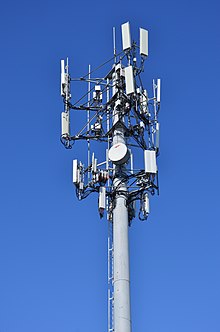
Back شبكة خلوية Arabic Mobil şəbəkə Azerbaijani Сотавая сувязь Byelorussian Сотавая сувязь BE-X-OLD Клетъчна мрежа Bulgarian সেলুলার নেটওয়ার্ক Bengali/Bangla Xarxa cel·lular Catalan Celulární rádiová síť Czech Карасла çыхăну CV Mobilfunknetz German


| Part of a series on |
| Antennas |
|---|
 |
A cellular network or mobile network is a telecommunications network where the link to and from end nodes is wireless and the network is distributed over land areas called cells, each served by at least one fixed-location transceiver (such as a base station). These base stations provide the cell with the network coverage which can be used for transmission of voice, data, and other types of content via radio waves. Each cell's coverage area is determined by factors such as the power of the transceiver, the terrain, and the frequency band being used. A cell typically uses a different set of frequencies from neighboring cells, to avoid interference and provide guaranteed service quality within each cell.[1][2]
When joined together, these cells provide radio coverage over a wide geographic area. This enables numerous devices, including mobile phones, tablets, laptops equipped with mobile broadband modems, and wearable devices such as smartwatches, to communicate with each other and with fixed transceivers and telephones anywhere in the network, via base stations, even if some of the devices are moving through more than one cell during transmission. The design of cellular networks allows for seamless handover, enabling uninterrupted communication when a device moves from one cell to another.
Modern cellular networks utilize advanced technologies such as Multiple Input Multiple Output (MIMO), beamforming, and small cells to enhance network capacity and efficiency.
Cellular networks offer a number of desirable features:[2]
- More capacity than a single large transmitter, since the same frequency can be used for multiple links as long as they are in different cells
- Mobile devices use less power than a single transmitter or satellite since the cell towers are closer
- Larger coverage area than a single terrestrial transmitter, since additional cell towers can be added indefinitely and are not limited by the horizon
- Capability of utilizing higher frequency signals (and thus more available bandwidth / faster data rates) that are not able to propagate at long distances
- With data compression and multiplexing, several video (including digital video) and audio channels may travel through a higher frequency signal on a single wideband carrier
Major telecommunications providers have deployed voice and data cellular networks over most of the inhabited land area of Earth. This allows mobile phones and other devices to be connected to the public switched telephone network and public Internet access. In addition to traditional voice and data services, cellular networks now support Internet of Things (IoT) applications, connecting devices such as smart meters, vehicles, and industrial sensors.
The evolution of cellular networks from 1G to 5G has progressively introduced faster speeds, lower latency, and support for a larger number of devices, enabling advanced applications in fields such as healthcare, transportation, and smart cities.
Private cellular networks can be used for research[3] or for large organizations and fleets, such as dispatch for local public safety agencies or a taxicab company, as well as for local wireless communications in enterprise and industrial settings such as factories, warehouses, mines, power plants, substations, oil and gas facilities and ports.[4]
- ^ "Cellular Networks, Cells, and Base Stations — EITC". www.eitc.org. Retrieved 22 November 2024.
- ^ a b Guowang Miao; Jens Zander; Ki Won Sung; Ben Slimane (2016). Fundamentals of Mobile Data Networks. Cambridge University Press. ISBN 978-1107143210.
- ^ Tom Simonite (24 January 2013). "Google's Private Cell Phone Network Could Be a Threat to Cellular Carriers | MIT Technology Review". Technologyreview.com. Archived from the original on 29 October 2013. Retrieved 23 November 2013.
- ^ "Private 5G Networks: 2024 – 2030". www.snstelecom.com. Retrieved 8 May 2024.